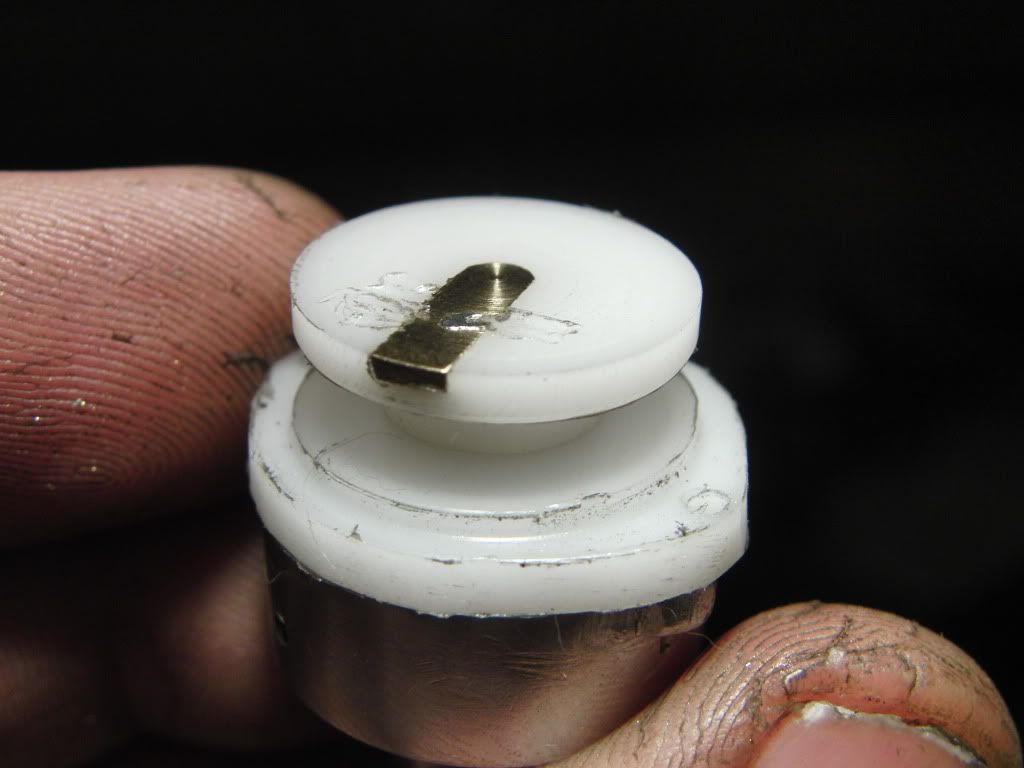Ignition tends to be a real difficulty with an IC model, especially when dealing with multiple cylinders. As the RPM goes up, and the number of cylinders goes up, the dwell time, the time the coil is being "charged", becomes smaller. Of course, the spark is fired when the points (mechanical or electronic) open.
I ran my engine yesterday for the first time in quite a while, and it ran well, except a couple of the cylinders were not firing; they were along for the ride. Oddly enough, they were at the top. Usually it is bottom cylinders that don't fire, being oil soaked and such.
This engine started life with a hall chip, but I could not keep the hall device alive, and in the end, went with a mechanical system, and a 12V car coil.
I decided to take the #1 cylinder down to check the valves, piston, rod, & plug, and to also check the distributor.

Everything looked good, mechanically. I was pleased at how little physical wear there was. This engine has been run hard. I pulled off the piston and checked the compression in the cylinder. It was satisfyingly "springy." Very little leakage. The rings looked good. The piston pin, rod, bushings, etc, all looked fine.
There was some carbon built up around the exhaust valve. This engine runs too cool... I wish there was some way to get it a bit hotter-running, but leaning it out results in too much unreliability.
On to the ignition. The rotor is a delrin turning with an adjustable contact made from a PC board. The set screws let me rotate the angle. Deeper in the base is a rotating disk that mounts the point set and lets me adjust spark timing during the run. The blue wire is there to allow this movement. Point contacts are mounted in another piece of delrin, to the right.

This pops free, and the mechanism of the distributor can be seen:

Hard to see, but there is a 9-lobed cam from hardened tool steel that actuates the point, a lever of brass with a steel cam insert. The gap is about 1mm. This drives a transistorized ignition.
I've always been suspicious that my ignition is weak, and I'd like to improve it, preferably outside the distributor. Here is the circuit I am using. I am not really smart on ignitions, and it is an area that I really need to brush up on.

The other problem with this setup is that the engine, stand, and circuit are positive ground, necessitated because of the NPN darlington. I will say this, it is robust in the sense that it has never failed. I simply feel that it is weak.
Would an increase in voltage give me a bit more "oomph?" Any suggestions are appreciated. I'd really like to get this thing where every cylinder fires every time, and evenly. Thanks!
I ran my engine yesterday for the first time in quite a while, and it ran well, except a couple of the cylinders were not firing; they were along for the ride. Oddly enough, they were at the top. Usually it is bottom cylinders that don't fire, being oil soaked and such.
This engine started life with a hall chip, but I could not keep the hall device alive, and in the end, went with a mechanical system, and a 12V car coil.
I decided to take the #1 cylinder down to check the valves, piston, rod, & plug, and to also check the distributor.

Everything looked good, mechanically. I was pleased at how little physical wear there was. This engine has been run hard. I pulled off the piston and checked the compression in the cylinder. It was satisfyingly "springy." Very little leakage. The rings looked good. The piston pin, rod, bushings, etc, all looked fine.
There was some carbon built up around the exhaust valve. This engine runs too cool... I wish there was some way to get it a bit hotter-running, but leaning it out results in too much unreliability.
On to the ignition. The rotor is a delrin turning with an adjustable contact made from a PC board. The set screws let me rotate the angle. Deeper in the base is a rotating disk that mounts the point set and lets me adjust spark timing during the run. The blue wire is there to allow this movement. Point contacts are mounted in another piece of delrin, to the right.

This pops free, and the mechanism of the distributor can be seen:

Hard to see, but there is a 9-lobed cam from hardened tool steel that actuates the point, a lever of brass with a steel cam insert. The gap is about 1mm. This drives a transistorized ignition.
I've always been suspicious that my ignition is weak, and I'd like to improve it, preferably outside the distributor. Here is the circuit I am using. I am not really smart on ignitions, and it is an area that I really need to brush up on.

The other problem with this setup is that the engine, stand, and circuit are positive ground, necessitated because of the NPN darlington. I will say this, it is robust in the sense that it has never failed. I simply feel that it is weak.
Would an increase in voltage give me a bit more "oomph?" Any suggestions are appreciated. I'd really like to get this thing where every cylinder fires every time, and evenly. Thanks!








